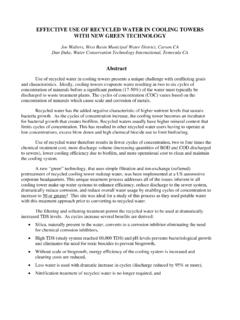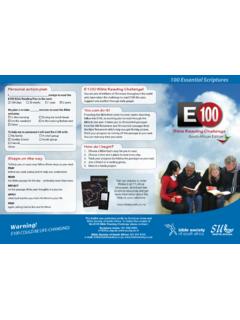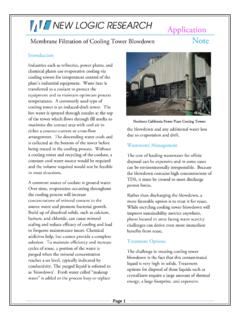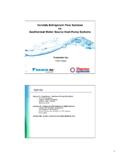Transcription of TREATING FRESH AIR - DRI America
1 1 Engineers, and Designers, today, constantly face the challenge to conceptualise, design and specify cost-effective solution for TREATING conditioning large volumes of FRESH air. The uses and need of FRESH air is not unknown to us. FRESH air is needed in virtually every sphere of life - whether to burn fuel, or for combustion of an engine or cleaning hazardous area of toxic or explosive gases to mention just a few. The most important need/use of FRESH air is for breathing - breathing healthy FRESH air. The focus of our paper today is TREATING conditioning this FRESH air cost effectively for man and his machine . it is brought into our living/working space. We will discuss various technolo-gies, equipments and methods of TREATING FRESH air and application of treated FRESH air. An ideal airconditioning equipment should sanitise cool, heat, humidify/dehumidify, evenly distribute the air through at the area; and all; cost effectively.
2 That is the challenge, the designer faces today. In this paper we will study the equipments/technologies available to treat FRESH air. FRESH Air Treatment Equipments Equipments available today to treat FRESH air are as varied as the uses of FRESH Air and can be categorised as- * FRESH Air Cleaning (for filtration & removal) * FRESH Air Ventilation (duly filtered) without supplementary cooling. * Direct Evaporative coolers (pad based desert/swamp coolers). * Indirect Evaporative Cooling Systems using rotary thermal wheel. * Treated FRESH air units incorporating heating/cooling coils. * Treated FRESH air units incorporating energy recovery devices. * Desiccant dehumidifiers for moisture/humidity control. * Desiccant based cooling systems. We will take a closer look at each of these equipments, their working and their uses, especially, the Desiccant Dehumidifiers and Treated FRESH Air Units with energy recovery (incorporating the enthalpy/heat wheel).
3 1. AIR PURIFICATION SYSTEMS FOR FRESH AIR CLEANING These systems are ideal for cleaning FRESH air intake from areas with hazardous contaminants like CO, or other industrial gases. They are self contained multistage units for continuous purification of toxic, odorous and corrosive industrial environment. Air purification systems can be categorised as using: * PIA-Potassium impregnated alumina, filter bank. * Activated carbon filters * or micronic filters TREATING FRESH AIR Options and Uses By Deepak Pahwa, President Bry-Air (Asia) Pvt. Ltd. 20, Rajpur Road, Delhi 110054 (India) This paper was presented at: - ISHVAC 99 (Nov 99), Shenzhen, China 22. EVAPORATIVE COOLERS The Evaporative Coolers have been used to cool from almost time immemorial. They are the most simple and at times most cost effective system of pretreating FRESH air for comfort applications. The evaporative cooler constitutes of a pad (corrugated/khus/wood wool) kept wet by water sprayed on it continuously.
4 Outside ( FRESH air) is cooled when drawn over the wet pads. And, cool air is supplied into the area to be conditioned with the help of a fan. Large Evaporative Cooling Systems Conventional Water spray type evaporative cooling/ventilation systems have given way to systems incorporating cellulose pads due to benefits offered. Cellulose pad based systems are efficient, less messy and takes up less space. Cooling is achieved by saturating the Ecocool Evaporative Pads with water, sprayed on to it through prefixed channels. Some typical applications of Evaporative cooling pads based systems are for - * Comfort cooling * Poultry, Hatchery * Green houses, floriculture * FRESH air intake for Gas Turbine 3. CONVENTIONAL TREATED FRESH AIR UNITS Conventional Treated FRESH Air Units incorporating Heating/Cooling Coils: These systems are generally used where large volume of FRESH is bought in. Most commercial applications need temperature and relative humidity control for comfort for which FRESH air needs to be treated.
5 A typical TFA unit consists of: * Double skinned AHU * Reheat section (optional) * Inlet filter * Blower & motor * Cooling section complete with cooling coil and a drain The FRESH air to be treated is drawn through the inlet over a filter and chilled down to apparatus dew point, by chilled water or refrigerant gas circulating in the coil. This cool, saturated air is heated to desired conditions over a reheat section, (which may have steam electric heating device) or is fed directly to the return air, closed circuit, AHU, to various areas. However, energy constraints, and ever increasing FRESH air demands necessitates replacement of conventional type of TFA unit with TFA units incorporating energy recovery devices as designers need to provide more FRESH air at lower energy costs. Before we discuss treated FRESH air units incorporating energy recovery let us review the need for incorporating energy recovery devices in the airconditioning system.
6 PumpCollection PanAir InAir OutCheck valveBleed offMake up waterStrainerSUMPW ater Spray Figure-2 Figure-1 Increased Ventilation Standard Vs Energy Management: The Challenge HVAC System "Wish List" for the '90s .. next millenium. * Efficiently handle increased outdoor air percentage (20~30 cfm vs. 5 cfm/person) with humidity control. * Minimise first cost, operating and maintenance costs. * Decouple the outdoor air load so that conventional packaged HVAC equipment can be used effectively. * Retrofit into existing system design. * Maintain space humidity between 30% - 60% RH all year. * Curtail peak electrical demand charges. * Reduce or eliminate the use of CFCs. As the recommended levels of outside air brought into conditioned space has been increased by 4 times (to 20~30 cfm up from 5 cfm per person), much higher latent and sensible loads are imposed on the cooling/heating equipment. This translates into two situations : (1) an improved indoor environment, and, (2) significantly higher utility bills for the owners.
7 Introduction of even a small quantity of air into an HVAC system raises physical plant requirements dramatically, bringing to fore a new dimension of balancing energy needs with the IAQ standard. In fact the HVAC designers are faced with several parameters which need to be incorporated in response to the regulations and guidlines laid down by market needs. 4. THE SOLUTION OPTIONS : ENERGY RECOVERY DEVICES As market needs for control of humidity, energy, IAQ, continue to rise, it is imperative to integrate heat/energy recovery devices to airconditioning design to keep all these requirements in mind. Types of Recovery Devices 1. Rotary Energy Exchangers/Enthalpy Wheels 4. Heat Pipe Heat Exchangers 2. Coil Energy Recovery Loop 5. Fixed Plate Exchangers 3. Twin-Tower Enthalpy Recovery Loop 6. Thermosyphon Heat Exchangers The ability to transfer both sensible and latent heat makes the enthalpy wheel far more effective in energy recovery.
8 It is found that the total heat recovery device typically recovers nearly three times as much energy as the sensible heat recovery device. The adjacent (Fig 3) chart compares typical effectiveness and pressure drop data for different recovery devices. It is seen that the enthalpy wheel has the highest effectiveness and least pressure drop at any face velocity, making it the most appropriate choice for energy recovery in comfort ventilation. Enthalpy Wheels : The Best Options for IAQ Enhancement The enthalpy wheel is a cylinder, usually 4 to 10 inches deep, packed with a heat transfer medium that has numerous small air passages, or flutes, parallel to the direction of airflow. Commonly referred to as the honeycomb matrix. The surface area exposed to airflow in a wheel lies between 300 to 3300 m2/m3, depending upon the configuration. Performance comparison Enthalpy Wheels vs Other Recovery Devices EFFECTIVENESS(%)PRESSURE LOSS(IN.)
9 WG.) 400 500 600 700 800 900 1000 FACE VELOCITY (FPM) EFFECTIVENESS PRESSURE LOSSCOIL TYPEHEAT PIPEPLATE TYPEHEAT WHEELPLATE TYPETWIN TOWERHEAT PIPECOIL TYPEHEAT WHEELF igure-3 4In a typical installation, the wheel is positioned in a duct system such that it is divided into two half moon sections. Stale air from the conditioned space is exhausted through one half while outdoor air is drawn through the other half in a counter flow pattern. At the same time, the wheel is rotated slowly (2 to 20 RPM). Sensible heat is transferred as the metallic substrate picks up and stores heat from the hot air stream and gives it up to the cold one. Latent heat is transferred as the medium condenses moisture from the air stream that has the higher humidity ratio through adsorption by the desiccant (with a simultaneous release of heat) and releases the moisture through evaporation (and heat pick up) into the air stream that has the lower humidity ratio.
10 Advantages of the New Generation Enthalpy Wheels .. What You See! Use of rotary heat exchangers in comfort air-conditioning dates back to mid fifties with folded wire mask pads since then the rotary heat exchangers or enthalpy wheels, as they are commonly known today how came a long way. The new generation of enthalpy wheels have several features which have distinct advantages over others, which need to be carefully studied before selecting the correct wheel for the application. *Selective adsorption which eliminates cross contamination of bacteria and air borne contaminates. In certain application areas such as hospitals, hotels, clean rooms and animal houses requiring stringent control of IAQ, where 100% FRESH air is normally the requirement, designers are apprehensive of using the heat wheel for fear of cross contamination due to carryover of bacteria, germs or foul odours from the exhaust to the incoming air.






